The crews who flew the bombers, fighters, and support aircraft carried out the most precise air campaign in history.” With those words, Defense Secretary William S. Cohen lauded the performance of US and Allied airpower in Operation Allied Force, NATO’s 78-day attack on the Yugoslavian regime’s brutal offensive in Kosovo. The United States-and especially USAF-dominated the campaign, a fact made inevitable by America’s near-monopoly on precision weapons. The attacks forced Belgrade to capitulate on June 9.
| Chronology of Key 1999 Events Jan. 16. More than 40 ethnic Albanians executed by Serbs are found in village of Racak in Kosovo. Massacre draws international condemnation.
Jan. 19.
Feb. 6.
March 15.
March 19. March 22.
March 24.
March 27.
April 1.
April 24.
May 2.
May 5.
May 7.
May 27.
June 3.
June 9.
June 10.
June 11.
June 20. |
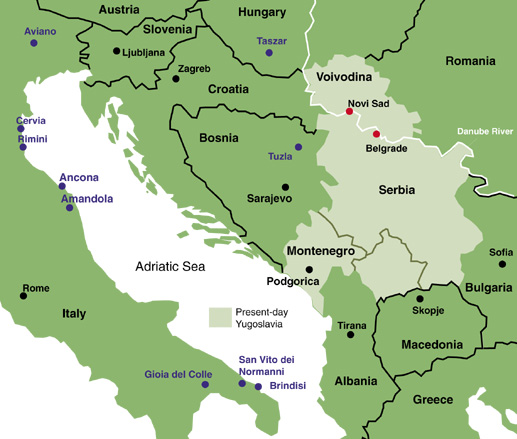 |
| Sorties |
| In a bit more than 11 weeks, NATO forces flew about 35,000 sorties, of which about 10,000 were attack sorties. The first phase of the air war was tentative, featuring limited attacks and vague objectives. In time, NATO shifted gears and stepped up the daily number of sorties. By the end of the war, NATO strike aircraft were flying nearly 400 missions on some days. Information on sorties remains incomplete. Poor weather caused aborts of many missions on some days. | 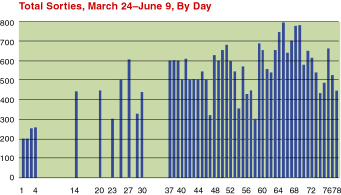 |
| The information on these pages is preliminary and drawn from several official sources, primarily NATO and Defense Department briefings presented almost daily during the war. Several different US and Alliance entities are conducting reviews, with sometimes significant variations in data. | 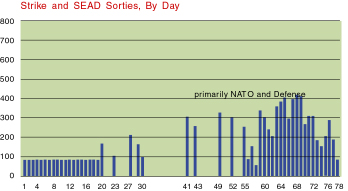 |
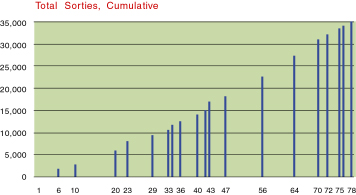 |
| Targets Struck |
| NATO struck (and restruck) a variety of targets in Serbia, which were deemed “strategic” targets, and in Kosovo, which were considered “tactical.” Some targets were hit by many different aircraft in a single raid. At first, NATO confined its attacks to a limited number of target groups. Day by day, the Alliance broadened the scope of its campaign. Strategic targets fell into six categories, as shown below. | 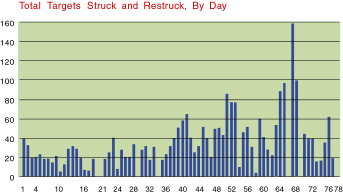 |
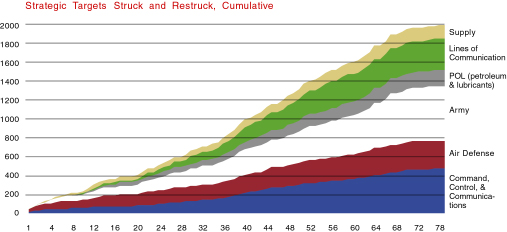 |
| Mobile Military Targets |
| NATO encountered difficulty locating and destroying mobile systems. By the time the Allies suspended bombing operations, officials thought they had destroyed considerable amounts of artillery and armored vehicles and were starting to consistently hit Serbian tanks. Definitive numbers weren’t yet determined. Numbers at right were provided by DoD on June 10 and subsequently confirmed by Army Gen. Wesley K. Clark, Supreme Allied Commander Europe. |
|
|||||||||||||||||||||||||||||
| Air Defense System |
| NATO fairly quickly achieved air superiority, neutralizing the fighter and missile elements of Yugoslavia’s integrated air defense system. Most of the time, the Serbs declined to turn on their tracking radars for fear of drawing an attack. Many systems remained in operation, however, and NATO remained wary until the end of the conflict. DoD said NATO pilots observed nearly 700 firings of SAMs, some of which could not be identified by type. |
|
||||||||||||||||||||||||||||||||||||||||||||||||||||||
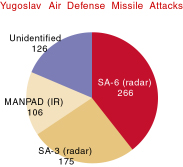
|
| Defense Industry, Infrastructure |
| Attacks from the air took a heavy toll on military-related industry and lines of communications. Yugoslavia’s refining industry virtually ceased to exist. The 3rd Army in Kosovo, responsible for the bulk of the atrocities, suffered the loss of 60 percent of its barracks, headquarters, storage sites, and other facilities. Power was turned off in as much as 80 percent of Serbia at a time. |
|
||||||||||||||||||||||||||||||||||||||||||||||||||||
| Aircraft Deployed |
| On March 24, the number of NATO aircraft committed to the air campaign numbered 400, of which 120 were strike aircraft. By the end of the war, the numbers were 883 and 550, respectively. US forces provided 581, or about 66 percent of the total. With the larger fleet, NATO commanders began to hit Serb assets with strikes from multiple directions and around the clock. | 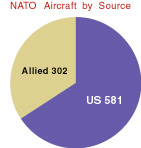 |
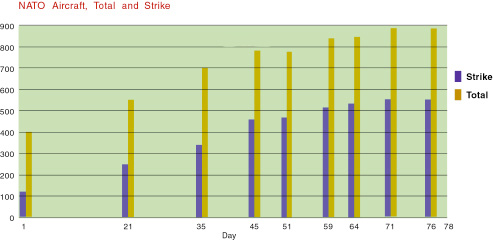 |
| Aircraft Types Contributed |
| Country | Aircraft | ||
| US (Air Force) | A-10, AC-130, B-1B, B-2, B-52H, C-5, C-17, C-130, C-135, C-141, E-3B/C, E-8C, EC-130, F-15, F-15E, F-16, F-117, KC-10, KC-135, MC-130, MH-53J, MH-60G, Predator UAV, RC-135, U-2S | ||
| US (Other) | EA-6B (Navy), F-14 (Navy), F/A-18 (Navy and USMC), KC-130 (USMC), P-3C (Navy), Hunter UAV | ||
| Belgium | F-16 | ||
| Britain | E-3D, GR-7, GR1, L-1011K, Tristar, VC-10, aircraft on HMS Invincible | ||
| Canada | CF-18 | ||
| Denmark | F-16A | ||
| France | C-135F, C-160, E-3F, F1, Jaguar, Jag-A, Mirage 2000C/D, MIR-IVP, Puma SA-330, Horizon, UAV CL-289, UAV CR, aircraft on FS Foch | ||
| Germany | Tornado PA-200H/E, UAV CL289 | ||
| Italy | AMX, Boeing 707T, F-104, PA2001, Tornado ADV, aircraft on ITS Garibaldi | ||
| Netherlands | F-16A, F-16AM, KDC-10 | ||
| NATO Common | E-3A | ||
| Norway | F-16A | ||
| Portugal | F-16A | ||
| Spain | CASA, EF-18, KC-130 | ||
| Turkey | F-16, KC-135, TF-16C |
